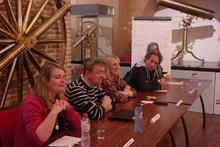news
Submitted on 2017-01-18
SWAP, the extreme ultraviolet (EUV) telescope aboard ESA's PROBA2 solar satellite, has been observing the Sun on a daily basis in 2016. The folks from the Proba2 Science Centre have made a collage by combining an image for each day into a single poster. The impressive result and some additional explanations are at ESA's Space in Images.
Submitted on 2017-01-17
Patrick S. McIntosh passed away on 16 October 2016. He is well known for the famous sunspot classification he developed.
Submitted on 2017-01-16Three challenges for which the belspo BRAIN-be was funded. Find out what it is about.
Submitted on 2017-01-05Regular solar observers have noticed that since mid-2016, the Sun has occasionally been devoid of sunspots. In fact, the month of December counted another 6 spotless days (see SDO-image from 10 December underneath). These spotless disks will gradually become a familiar feature as the solar cycle is heading for its next minimum, currently expected by the end of this decade. The number of spotless days can vary significantly from one solar cycle transit to another.
Submitted on 2016-12-22On December 20, 10:30 UT, 2016, an USET observer made a drawing of sunspot A1. Nothing special? It is, definitely.
May we present to you the very first sunspot of solar cycle 25.
Submitted on 2016-12-05The PROBA2 satellite was launched in November 2009, well in time to catch the first X-class flare of the new solar cycle (15 February 2011). The "X" in X-class flares stands for "eXtreme", and that's exactly what these flares are: the strongest class of rontgen flares that the Sun can produce.
Submitted on 2016-11-29On 24 November 2016 around 07:31UT, a brief brightening was observed in extreme ultraviolet imagery (EUV) from the Solar Dynamics Observatory (AIA094; top row images), indicating a small reconnection event. The related white-light images (bottom row) show that this reconnection took place near the southwest border of NOAA 2612's main sunspot. See the imagery underneath at resp. 07:30:12, 07:31:24UT, 07:35:00 (timings for AIA094).

Submitted on 2016-11-07Once again, solar activity has been very low last week. One could wonder how poor the performance of ongoing solar cycle 24 (SC24) has been compared to the previous solar cycles. For that, one could use the famous NOAA-scales which link objective solar parameters such as the x-ray flux to all kinds of practical space weather effects such as on radio communication. More details can be found on the NOAA/SWPC webpage.
Submitted on 2016-11-04Early October 26, 2006 the two STEREO spacecraft were launched. The twin spacecraft had to observe the Sun in stereo. Both have a similar orbit as the earth, one ahead, the other trailing behind.
Pages
Zircon - This is a contributing Drupal Theme
Design by
WeebPal.
































